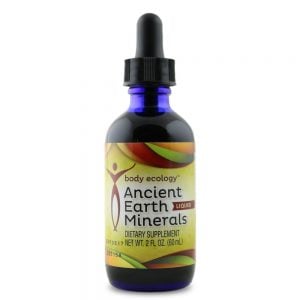Is Your Thyroid Healthy? 5 Signs of an Underactive Thyroid
Do you know the telltale signs of an underactive thyroid, or hypothyroidism?
The thyroid gland is a small, butterfly-shaped gland that sits just below the thyroid cartilage. The thyroid can:
- Lift your energy.
- Warm your body.
- Activate your immune system.
Do you feel like you’re always the first to catch a cold? An increased susceptibility to the common cold and flu is one possible sign of an underactive thyroid, but supplementing with high-quality Ancient Earth Minerals may nourish the thyroid and strengthen immunity.
It can also tell the body to slow down. Sometimes, the thyroid slows down so much that it becomes underactive. When this happens, the thyroid gland does not do its job, and the whole body suffers. This is what is known as hypothyroidism.
As our understanding has broadened and hypothyroidism diagnosis has become more common, the detection and treatment are getting a second look by doctors. In 2015, a study published in the Journal of Epidemiology & Community Health made a critical link between environmental factors and thyroid disorders, associating high water fluoridation in England with 30 percent higher rates of underactive thyroid.1 Without proper treatment, hypothyroidism can affect all areas of life — impairing driving similar to the effects of alcohol, in some cases, and even compromising a child’s intellectual development when a mother has hypothyroidism during pregnancy.2,3
Testing for Hypothyroidism Can Be Tricky
A major issue has erupted in the medical community. Many doctors are now disagreeing over what tests should be done to check thyroid function. Traditionally, TSH, Thyroid-Stimulating Hormone that is released from the pituitary gland in the brain, would be checked along with the two thyroid hormones it produces, T3 and T4.
However, it has become commonplace to only test for TSH, and that is just one part of a very detailed picture. There are many other mechanisms at work in thyroid health.
For example, healthy thyroid activity relies on:
- Stable levels of other hormones, like estrogen and progesterone. Too much estrogen, such as from the birth control pill, will create too many thyroid-binding proteins.
- A healthy immune system. Autoimmune hypothyroid can be missed by TSH blood panels.
- Beneficial bacteria in the gut. Antibiotics wipe out these good microbes, which account for around 20 percent of the conversion of T4 into usable T3.4
- An uncongested and healthy liver. The liver converts over half of T4 from the thyroid into usable T3.
- Good adrenal function. Adrenal fatigue can slow down the function of the pituitary and hypothalamus in the brain. These three glands are a part of what is called the HPA axis (hypothalamus-pituitary-adrenal axis). An alert and healthy pituitary is essential for good thyroid function.
Clearly, with so many pathways available for the production and conversion of thyroid hormones, there are a lot of opportunities for something to go wrong.
Many people are diagnosed with this condition and given thyroid medication. Sometimes, this medication will show improvements in lab analysis as hormone levels fall into normal range. But many people still have symptoms.
Researchers have been pushing for new treatment options for hypothyroidism for this very reason: The standard treatment of taking thyroid hormones may not relieve all symptoms for up to 15 percent of patients. Based on the results of 2015 studies published in the Journal of Clinical Investigation (JCI) and the Journal of Clinical Endocrinology & Metabolism (JCEM), researchers urged doctors to treat the condition with personalized medicine because “hypothyroid patients are not all the same.” 5,6 A treatment that works well for one patient may not work for another.
What Are the Signs of an Underactive Thyroid?
Doctors are now investigating why thyroid tests may appear normal, but the thyroid itself may still be dysfunctional.
Seeing a pattern will help you determine if your thyroid medication is properly treating an underactive thyroid, or if more diagnosis is necessary:
1. Edema is the abnormal accumulation of fluid beneath the skin. The edema that occurs in hypothyroidism is the “non-pitting” form of edema.
- “Non-pitting” means: You press your finger into the flesh, and it bounces right back and leaves no mark.
- This is called myxedema, which is specifically associated with low levels of thyroid hormones.
- Myxedema is swelling of the arms, legs, and face.
- The bounce-back is due to springy molecules called GAGs (glycosaminoglycans).
- GAGs are an important element in connective tissue.
- In myxedema, they also accumulate beneath the skin with extracellular fluid.
2. Is there persistent weight gain, especially around your torso, that you just can’t lose no matter how frugal you are with calories?
Dr. Roby Mitchell tells us that thyroid hormones help insulin move glucose from blood into the cells. “When thyroid levels are low, more insulin is needed to maintain normal glucose. More insulin means more fat cell hyperplasia, which shows up as increased fat deposition.”7
The adrenals lose strength when the thyroid is underactive, which also slows down metabolism.
3. Cold hands and cold feet may mean lack of blood flow.
Low thyroid activity can be associated with too much homocysteine — an amino acid associated with heart disease, poor blood flow, and stiff vasculature. This is because the essential nutrients carried in the blood do not reach the extremities as frequently. Lack of blood flow to the extremities, like your hands and feet, can also show up as chronic fungal infections.
4. Nagging infections could indicate an underactive thyroid.
Dr. Mitchell points out that because beta-carotene depends on thyroid hormones in order to convert into vitamin A, beta-carotene can build up in the body and cause yellow skin, especially in the hands. The official name for this is called carotoderma. Vitamin A plays an important role in immune system health. What happens when the body cannot convert beta-carotene into vitamin A? The body may become more susceptible to infections, or it simply may not have the strength to kick a bug.
5. Excessive hair loss, painful joints, and other signs of dryness.
The springy molecules mentioned earlier, GAGs, give connective tissue its supportive quality — like collagen and bone. Dr. Mitchell tells us that these molecules are “water magnets.” Without GAGs inside cells, cells cannot retain water. This goes back to the crystalline structure that GAGs give to connective tissue like collagen and bone.
What do dry, leaky cells look like to us?
- Wrinkled skin
- Lusterless hair
- Brittle nails
- Painful joints associated with osteoarthritis
Iodine — Make Sure It’s Right for You
Because there are so many pathways to an underactive thyroid, including autoimmune hypothyroid, be careful when supplementing with iodine. Iodine, while central to the production of thyroid hormones T3 and T4, can actually make some hypothyroid conditions worse. This is because iodine speeds up the production of a thyroid enzyme.
If the body has developed autoimmunity to this enzyme, which happens in the case of Hashimoto’s thyroiditis, then this will increase the inflammatory cascade:8
- Iodine is not a cure-all.
- Diagnosis, knowing the mechanism responsible for an underactive thyroid, is paramount.
Using iodine to address a thyroid condition does not take into account autoimmune hypothyroid. It also does not address diet or lifestyle, which can make a tremendous impact on thyroid hormone levels.
This is why we recommend working with a qualified healthcare practitioner, while at the same time:
- Healing the gut. Follow the Body Ecology Diet and use Vitality SuperGreen to help heal the gut lining.
- Populating the gut with good microbes. Remember, gut flora convert 20 percent of T4 into usable T3 — eat probiotic-rich fermented foods and drink probiotic beverages like InnergyBiotic with every meal!
- Regulating the immune system. Follow the Body Ecology Principles and take alkalizing minerals (that also nourish the thyroid).
- Repairing any blood sugar imbalances through Body Ecology Principles.
A 2013 study conducted in eight major cities and published in the Indian Journal of Endocrinology and Metabolism confirmed that almost one-third of hypothyroid patients were not aware that they had the condition until they were diagnosed for the first time.9 Paying attention to pressing health symptoms that could point to a thyroid disorder — and strengthening the gut to regulate thyroid function — has never been more important.
A healthy thyroid is reliant on a healthy gut, and common digestive disorders like diarrhea, constipation, heartburn, and leaky gut can be a hindrance to optimal thyroid health. As complex as it seems, hypothyroidism may be quite simple. Many times, an underactive thyroid is your body’s way of telling you that your gut needs help.
What To Remember Most About This Article:
The thyroid gland plays an important role in:
- Warming the body.
- Giving the body energy.
- Pumping up the body’s immune system.
There are five clues that may indicate your thyroid is underactive:
- A special kind of edema (swelling) called myxedema.
- Abdominal weight gain.
- Cold hands and feet.
- Persistent infections or catching colds easily.
- Hair loss, dry skin, brittle nails, and achy joints.
If your thyroid is crying out for help, the answer may be found within your gut. Good thyroid health depends on good gut health, and you can begin on your gut-healing journey by following the Body Ecology Diet and by strengthening the gut lining with Vitality SuperGreen. From there, populate the gut with good bacteria found in fermented foods and drinks like InnergyBiotic — beneficial gut bacteria are responsible for converting 20 percent of thyroid hormone into its usable form. And last but not least, give the thyroid and the immune system extra support each day with a dose of nourishing, alkalizing liquid minerals.
REFERENCES:
- S Peckham, D Lowery, S Spencer. Are fluoride levels in drinking water associated with hypothyroidism prevalence in England? A large observational study of GP practice data and fluoride levels in drinking water. Journal of Epidemiology & Community Health, February 2015 DOI: 10.1136/jech-2014-204971.
- Endocrine Society. “Hypothyroidism may lead to impaired driving.” ScienceDaily.
- Alex Stagnaro-Green, Marcos Abalovich, Erik Alexander, Fereidoun Azizi, Jorge Mestman, Roberto Negro, Angelita Nixon, Elizabeth N. Pearce, Offie P. Soldin, Scott Sullivan, Wilmar Wiersinga. Guidelines of the American Thyroid Association for the Diagnosis and Management of Thyroid Disease During Pregnancy and Postpartum. Thyroid, 2011; 110725061557002 DOI: 10.1089/thy.2011.0087.
- de Herder, WW, et al. On the enterohepatic cycle of triiodothyronine in rats; importance of the intestinal microflora. Life Sci. 1989; 45 (9): 849 – 56.
- Joao Pedro Werneck de Castro, Tatiana L. Fonseca, Cintia B. Ueta, Elizabeth A. McAninch, Sherine Abdalla, Gabor Wittmann, Ronald M. Lechan, Balazs Gereben, Antonio C. Bianco. Differences in hypothalamic type 2 deiodinase ubiquitination explain localized sensitivity to thyroxine. Journal of Clinical Investigation, 2015; DOI: 10.1172/JCI77588.
- Elizabeth A. McAninch, Sungro Jo, Nailliw Z. Preite, Erzsébet Farkas, Petra Mohácsik, Csaba Fekete, Péter Egri, Balázs Gereben, Yan Li, Youping Deng, Mary Elizabeth Patti, Chantal Zevenbergen, Robin P. Peeters, Deborah C. Mash, Antonio C. Bianco. Prevalent Polymorphism in Thyroid Hormone-Activating Enzyme Leaves a Genetic Fingerprint that Underlies Associated Clinical Syndromes. The Journal of Clinical Endocrinology & Metabolism, 2015; jc.2014-4092 DOI: 10.1210/jc.2014-4092.
- Mitchell, Roby. The Clinical Picture of Hypothyroidism. Holistic Primary Care: News for Health and Healing. 2008, Fall; Vol. 9 (3).
- Camargo RY, Tomimoria Ek, Neves Sc, et al. Thyroid and the environment: exposure to excessive nutritional iodine increases the prevalence of thyroid disorders in Sao Paulo, Brazil. Eur J Endocrinol. 2008 Sep;159(3):293-9.
- Indian J Endocrinol Metab. 2013 Jul-Aug; 17(4): 647–652.









